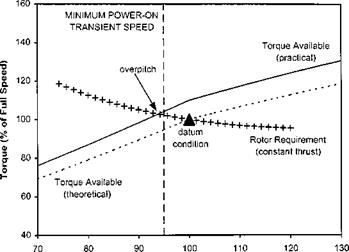Fixed turbine enginelrotor characteristics
Figure 6.5 shows the torque versus RRPM characteristics for a fixed turbine engine/ rotor combination. As with the free turbine engine the rotor requirement is essentially a constant power line. The engine torque, however, unlike the free turbine engine, does not match the torque requirement of the rotor in that it is of the opposite slope. As discussed above this is because a reduced rotor speed implies a reduced engine speed and consequently there is less gas power for the turbine to convert. A limiting condition, known as the overpitch point, occurs when the reducing engine torque output (at maximum power) just equals the increasing torque requirement of the rotor. To the left of this point the system is unstable; as NR reduces further the rotor requires
|
|
|

more torque but the engine produces less and less. Hence RRPM rapidly decays with a consequent loss of lift.
Overpitch can easily be induced by demanding too much power – collective pitch – at too low a RRPM. The only way to recover from overpitch is to reduce collective and increase the airflow through the rotor, thereby increasing NR and bringing it back to the right of the cross-over point. This technique inevitably involves a large loss of height.
On the modern fixed turbine helicopter, RRPM control is achieved automatically by the engine control system. However, control systems are not perfect – if they were, an exactly constant NR could be maintained independent of any flight manoeuvres, and one could fit an engine that just met the torque requirement at this NR (dotted line in Fig. 6.5). In practice, allowances must be made for transient droop – there must therefore be a stable range of operating RRPMs to the right of overpitch – and so an engine must be fitted which has a torque output similar to that denoted by the solid line. When comparing this practical engine with the theoretical one it is clear, first of all, that the practical powerplant needs to be a more powerful device. At the same time all the potential power cannot be used, otherwise the transmission system would be overtorqued, and so the engine must be limited or downrated in some way. One other consideration is that this practical engine will always be operating at partial powers; that is at much lower temperatures and pressure ratios than originally designed. Hence the thermal efficiency will be reduced and the SFC higher. Briefly then, to achieve a satisfactory and practical RRPM range, the fixed turbine helicopter engine must be downrated to preserve torque limitations. For example, the Alouette 3 helicopter is fitted with a 649 kW (770 SHP) Artouste IIIB engine downrated to 425 kW (570 SHP). One advantage of the downrating is that a power margin exists that gives the aircraft similar performance right up to the altitude at which the engine becomes the limiting factor – normally above 15 000 ft (4500 m) – which is why rotorcraft like the Lama have such good high altitude performance.












